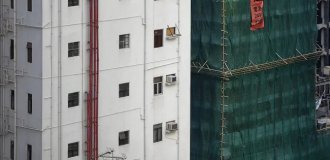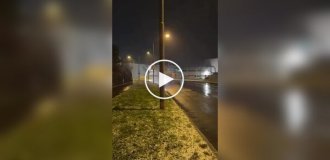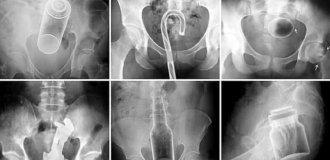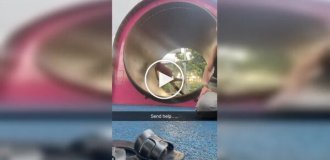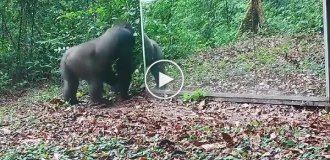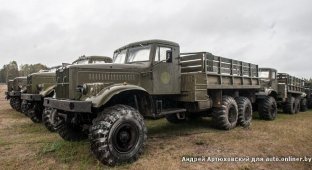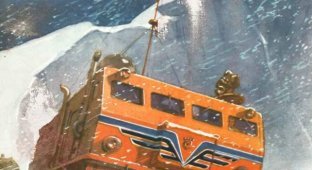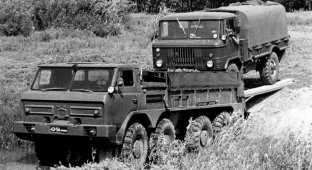Civil versions of Soviet missile carriers (27 photos)
Over the decades of existence of heavy army chassis vehicles of the MAZ-543 series, the impression was created that all the vehicles included in it were strictly classified and performed only vital military tasks to protect the Country of the Soviets, related to the carrying and use of the most powerful ballistic intercontinental missile systems. In fact, everything was not like that.
These vehicles were classified only during the process of their development and introduction into production, and the classification of secrecy was imposed only on the types of weapons and special equipment mounted on them. As a result, with the start of production of army four-axle aircraft, they immediately had civilian versions capable of performing their functions in the country’s armed forces and in the national economy.
The impetus for the implementation of this process was a government decree of January 1966, obliging the Minsk Automobile Plant to send 5-10% of its military products monthly for peaceful needs.

Dual-purpose MAZ-543P truck as a military training vehicle

MAZ-543P (1966–1974)
In pursuance of the instructions of the highest authority, in the same year the plant introduced a multi-purpose airborne version of the MAZ-543P with a payload of 19.6 tons, built on the MAZ-543 military chassis. Its main external differences from combat vehicles were the low-sided all-metal cargo platform with wooden lattice extensions, the lack of special army equipment and blackout devices.
MAZ-543P car with a low-sided body in civil engineering
During the first year, 80 MAZ-543P cars were assembled, and before the end of production, a total of over two thousand cars were born. Initially, they were planned to be used at enterprises of the oil and gas production complex of the USSR in remote regions of the country with a poorly developed road network, but gradually the range of their use expanded to industry, construction and logging.
In the 1970s, a prototype tractor with an experimental gas turbine engine with a capacity of 1,100 hp was built and tested on the MAZ-543P chassis. With. Yaroslavl Motor Plant.

Testing of a MAZ-543P vehicle with a gas turbine engine

MAZ-7310 family (1973–1991)
The intensification of work on civilian versions of military vehicles took place in the early 1970s and was directly related to the implementation of the promising project of a more powerful army family “Oplot” (discussed later). The idea of combining developments and introducing two unified types of vehicles at once, military and civilian, could significantly reduce costs and time for expensive research and would allow simultaneous testing of different types of vehicles with different units and components.
Civil 20-ton MAZ-7310 vehicle with a high-sided body
In reality, it was not possible to achieve good results in this matter: the new national economic versions were still based on units of the 543 series machines and had nothing in common with the Oplot family. As a result, new vehicles for civilian sectors of the economy were only light modifications of well-known army trucks without shielded electrical equipment, blackout devices, communications equipment and other military attributes. All of them had their own markings and dual purposes, but never took root either in the national economy or in the Soviet army.

Basic dual-purpose onboard vehicle MAZ-7310
The first to appear in 1973 was the MAZ-7310 tractor-trailer, adapted for towing heavy trailers. Its base was the MAZ-543 army chassis with a 525-horsepower diesel engine and a hydromechanical transmission. The main external distinctive feature of the vehicle was the high-sided all-metal cargo platform. On each side it had two metal sides, which folded down separately or together with the middle pillar and were equipped with lattice extensions, together with which their total height reached two meters. Wide-profile 14-ply tires were also an unnoticeable novelty. An onboard vehicle option was the 22-ton MAZ-73101 chassis with reinforced rear suspension.

A militarized version of the MAZ-7310 during acceptance tests at 21 Research Institutes
In 1974–1975, the MAZ-7310 vehicle coupled with the MAZ-8950 two-axle trailer passed state acceptance tests at 21 Research Institutes. It was not accepted for service, but in the Soviet army these vehicles were used in small quantities for minor rear transport, for installing simple superstructures and as training aids. Traditionally, they were all green, but in civilian life they were distinguished by their ridiculous and immediately noticeable bright yellow-orange color.
In 1974, this range was supplemented by two more civilian vehicles: a prototype of the 19-ton MAZ-7510 construction dump truck and a reinforced MAZ-7910 chassis with rear suspension units from the Oplot series. The latter option was used for transporting long pipes, rolled metal, sawn wood (cuts) and remained in production for 12 years.

Test sample of a MAZ-7510 dump truck with rear unloading

Multipurpose chassis MAZ-7910 for transportation of long cargo
For experimental purposes, an experimental combat laser complex “Drift” was mounted on two MAZ-7910 chassis, which consisted of a technological machine with a quantum generator and a launcher with a telescopic laser beam guidance system. There is no information about his further fate.

Transportation of indivisible cargo on a 300-ton ChMZAP-8389 trailer with a MAZ-7310 tractor and pusher

MAZ-7310 tractors when towing a multi-axle trailer with heavy bulky cargo
In the national economy, cars of the MAZ-7310 family and their derivatives were planned to be used primarily for the delivery of large indivisible cargo and towing trailers weighing up to 25 tons in remote regions of the USSR with a harsh climate. Transport companies installed additional fuel tanks with a capacity of up to 1,220 liters on them, providing a record high range of up to 1.5 thousand km, allowing them to cover long distances in the complete absence of gas stations and repair shops.

Modernized MAZ-7313 truck
In 1986, the MAZ-7310 series was replaced by the modernized 21-ton truck MAZ-7313 and the MAZ-73131 chassis with a payload of about 23 tons. They were also based on MAZ-543 units, but they began to more widely use reinforced spar frame and chassis components parts from the army range "Oplot".

Winter tests of the MAZ-7313 multi-purpose truck

Dual-purpose tractor MAZ-7313 in the Soviet army
This program was completed by the experienced short-wheelbase airfield tractor MAZ-73132 with a shortened all-metal cargo platform and the 23-ton timber transporter MAZ-73136 with a two-axle trailer. In general, all the main operational parameters of the 7310/7313 series did not differ from the basic military versions.

Timber transporter MAZ-73136 with a trailer for transporting sawn wood
In the civil service, where these cars were nicknamed “Hurricane” for their high power and good cross-country ability among drivers, they turned out to be too unusual for Soviet drivers, complex, expensive and did not become widespread in civilian life. Small-scale assembly of a number of versions continued until 1991.

Truck cranes on the MAZ-7310 family chassis
On the civilian chassis MAZ-73101 and MAZ-73131, the Odessa Plant named after the January Uprising and its successor JSC Krayan installed equipment for heavy multi-purpose hydraulic dual-purpose truck cranes. They no longer found proper use in the army and were used mainly in the national economy for general lifting work and in construction.
Multipurpose 25-ton crane KS-5573 on MAZ-73101 chassis

Commemorative photo on the KS-5573 truck crane, which served at the cosmodrome in Plesetsk
Since 1981, the 25-ton truck crane KS-5573 on the MAZ-73101 chassis, a direct successor to the military model KS-5571, has been in production. It was created for use at oil producing enterprises in Western Siberia, but in isolated samples it served in large northern military formations of the USSR Air Force and Navy. An autonomous power unit of 50 liters was also mounted on it. With. and a two-section boom 14 m long.

Modernized 25-ton truck crane KS-5574 on MAZ-73131 chassis
In the 1990s, its development was the KS-5574 version on the MAZ-73131 chassis with a three-section boom extending 32 m in length, and the new successor to the 5571 model in terms of general design and configuration was the multi-purpose 40-ton hydraulic crane KS-6571 with 18- meter boom and its own power unit to drive working equipment.

Heavy truck crane KS-6571 from the fire rescue unit

Fire trucks in the MAZ-7310/7313 family
The most well-known purpose of vehicles of this family was heavy airfield fire trucks with high cross-country ability for the rapid implementation of rescue operations and extinguishing aircraft fires directly on the runways of large airfields of the USSR Air Force and in the surrounding areas.
Airfield fire truck AA-60 (7310)-160.01 on MAZ-7310 chassis
The first attempt to create our own multi-axle dual-purpose fire engines took place in 1975, when the AA-60 (7310)-160.01 airfield vehicle appeared on the MAZ-7310 chassis. It was a massive red machine with a total weight of 43 tons, developing an incredible speed of 60 km/h on the concrete surfaces of military and civilian airfields, which made it possible to deliver fire-fighting equipment to an emergency aircraft in a relatively short time.
In those days, the main means of extinguishing fire remained ordinary water, which was transported in a tank with a capacity of 12 thousand liters, and to increase efficiency, special substances were mixed into it to form a large volume of foam, which prevented the combustion process. To throw water and foam onto the burning object, a powerful fire monitor and special nozzles under the bumper were used to distribute them over the fire surface. To drive the water pump, the car was equipped with an additional 180-horsepower engine.

Powerful airfield foam fire fighting vehicles AA-60 (7310)-160.01

In the mid-1980s, fire-fighting equipment began to be rearranged on the MAZ-7313 chassis, which led to the creation of a modernized version AA-60 (7313)-160.01, which was generally no different from its predecessor.

Fire truck AA-60 (7313)-160.01 without a fire monitor at the training ground of the Ministry of Internal Affairs

Machine AA-60 (7313)-160.01 foam extinguishing at one of the military airfields
In 1979, based on the MAZ-7310, a new fire truck AA-70 (7310)-220 was built with a tank for 9.5 thousand liters of water for traditional fire fighting with ordinary water and foam. The “highlight” of this machine was the use of a new method of extinguishing fires with extinguishing powder, which was ejected under air pressure through a second small-diameter monitor.

Powerful airfield fire fighting vehicles for combined extinguishing AA-70 (7310)-220

Later, this equipment was installed on a modernized version of the AA-70 (7313)-220. In this series, for the first time, a version appeared with a standard fire monitor between the cabins and two fire hoses on a six-meter lifting mast, which were used to fight fire at heights or over large areas.

Airfield vehicle AA-70 (7313)-220 with a lifting mast on a MAZ-7313 chassis
Compared to their foreign counterparts, heavy Soviet fire trucks did not meet stringent international requirements for speed and dynamics of movement through airports, but all of them for the first time made it possible to come close to a higher level of development of our fire fighting vehicles.



